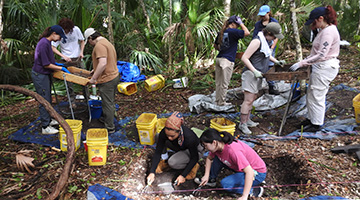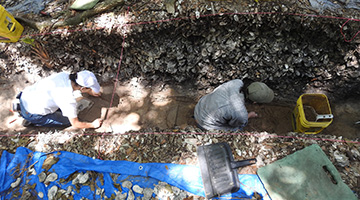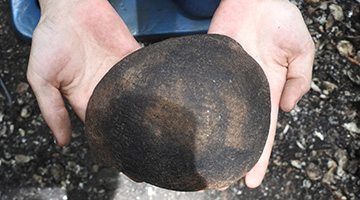UNF Archaeology team and NPS begin new dig at Timucuan Ecological and Historic Preserve
 More than 20 University of North Florida archaeology students are spending their summer digging deep in the dirt within the Timucuan Ecological and Historic Preserve.
More than 20 University of North Florida archaeology students are spending their summer digging deep in the dirt within the Timucuan Ecological and Historic Preserve.
This project and preliminary testing by the UNF team over the past several months marks the beginning of a large-scale collaboration between UNF and the National Park Service (NPS). The results of their research and tests, along with other archaeological work at the site will contribute greatly to understanding of the Indigenous people and the environment of northeastern Florida approximately 800 to 1,000 years ago.
The team is led by Dr. Keith Ashley, an UNF archaeology professor who has worked to uncover local history for over 20 years, and recent UNF anthropology graduate Victoria Hayes, who is interning for the NPS and has been accepted in the University of Florida’s PhD program.
 The site consists of large mounds and ridges of densely packed shell-midden refuse. The team is currently excavating a long trench through one of the shell ridges and testing other shell formations. They are also using a total station to create detailed topographic maps of the shell formations.
The site consists of large mounds and ridges of densely packed shell-midden refuse. The team is currently excavating a long trench through one of the shell ridges and testing other shell formations. They are also using a total station to create detailed topographic maps of the shell formations.
“We want to understand if these unique formations are intentional human-made architecture or mere piles of refuse and how the Indigenous people were using this area,” said Ashley.
The massive piles of shells and other cultural materials were deposited about 1,000 years ago. Testing of these shell formations has uncovered artifacts, mostly consisting of Indigenous pottery. St. Johns — a chalky ware tempered with the spicules of freshwater sponges — is most common, with check stamped and plain surface decorations. One test had a considerable amount of San Marcos pottery, likely associated with the 17th-century Mocama community of Guadalquini located to the south. In addition to shell and pottery, the bones of fish, deer, turtles and other animals have been recovered by UNF students this summer.
Background site research
 In spring 2023, Ashley and Hayes began background research on the site. First recorded in the 1950s by John Goggin, the area contains an impressive series of shell mounds and ridges of varying shapes and sizes distributed over a broad area. Other than surface collections made by Goggin, the only other archaeological work conducted at the site was limited testing performed in the 1990s by surveyor Mike Russo, who was contracted by NPS to survey select portions of the Timucuan Preserve. Russo’s survey recovered pottery, but only one of the shell mounds was ever tested.
In spring 2023, Ashley and Hayes began background research on the site. First recorded in the 1950s by John Goggin, the area contains an impressive series of shell mounds and ridges of varying shapes and sizes distributed over a broad area. Other than surface collections made by Goggin, the only other archaeological work conducted at the site was limited testing performed in the 1990s by surveyor Mike Russo, who was contracted by NPS to survey select portions of the Timucuan Preserve. Russo’s survey recovered pottery, but only one of the shell mounds was ever tested.
After the UNF team consulted LiDAR imagery and conducted a quick reconnaissance survey, they saw many densely packed shell mounds, ridges and arc formations beneath a dense tree canopy on the site, including a serpentine-shaped ridge stretching nearly 185 meters along the marsh edge.
Following a field visit in spring 2023, the UNF team decided to undertake the first brief project in July 2023. Hayes applied for and was awarded a Timucuan Preserve student research grant to map, sample and date a couple of the shell formations. After securing a federal permit for archeological investigations (ARPA) permit from the NPS, Ashley, Hayes and four UNF field school students spent a week in July mapping and testing the two southernmost shell formations present at the site.
“It was an incredible experience to be able to work on this project from the beginning,” said Hayes. “I participated in all the aspects of archaeology work by applying for funding, conducting background research, developing a research design, reporting, field work and lab work. It really solidified my true passion and love for archaeology.”
The research happening this summer began May 13 and students will be in the field digging five days a week through June 14. Next summer, the team plans to return to the site and continue to uncover history.
